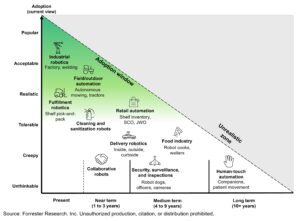The Robots Are Not Coming — They Are Already Here: The Future Of Physical Automation Will Be People-Driven
Automation is having a moment. Generative AI and large language models have the spotlight, but physical automation has advanced, as well. First, the pandemic gave life to robots for cleaning and disinfection. Labor shortages then left businesses scrambling to just keep the place running. Look around, and you can see physical automation trying to sneak into many workplaces and customer hangouts, but it’s a struggle. Physical robotics is not like cognitive automation that is more transparent to humans, like that virtual agent hidden in some cloud — it’s more in your face. You get entertained by a robot waiter or startled by a worker in an exoskeleton walking by holding a car, or you yell at the poor design of a self-checkout kiosk.
We gathered the analysts who touch on physical automation at Forrester for our latest report, The Future Of Physical Automation. We analyzed the trends that will drive adoption and settled on 10 physical automation categories. We then asked experts to comment on their near- and long-term prospects. Halfway through the project, we realized that, in their own way, they were saying the same thing: The “people” effect will drive adoption, so we developed a model to gauge just that. We will unveil the model and report findings in an on-demand webinar for Forrester clients.

This current forecast is a snapshot in time. Human acceptance, technology readiness, and economic pressure will push or pull an automation up in the adoption window. For additional insight in evolving physical automation opportunities, read The Future Of Physical Automation report, or set up some time for a discussion with us. Contact Craig Le Clair (cleclair@forrester.com), Paul Miller (pmiller@forrester.com), or Renee Taylor-Huot (retaylor@forrester.com).
